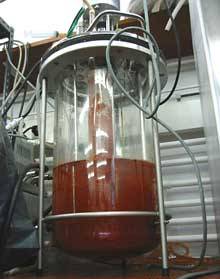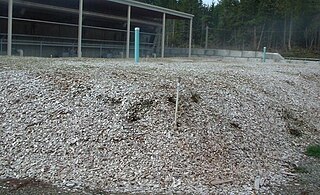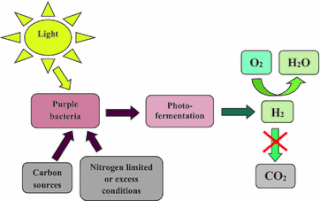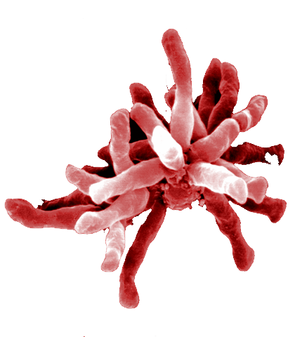Related Research Articles

Bioremediation broadly refers to any process wherein a biological system, living or dead, is employed for removing environmental pollutants from air, water, soil, flue gasses, industrial effluents etc., in natural or artificial settings. The natural ability of organisms to adsorb, accumulate, and degrade common and emerging pollutants has attracted the use of biological resources in treatment of contaminated environment. In comparison to conventional physicochemical treatment methods bioremediation may offer considerable advantages as it aims to be sustainable, eco-friendly, cheap, and scalable.
Anaerobic respiration is respiration using electron acceptors other than molecular oxygen (O2). Although oxygen is not the final electron acceptor, the process still uses a respiratory electron transport chain.

Denitrification is a microbially facilitated process where nitrate (NO3−) is reduced and ultimately produces molecular nitrogen (N2) through a series of intermediate gaseous nitrogen oxide products. Facultative anaerobic bacteria perform denitrification as a type of respiration that reduces oxidized forms of nitrogen in response to the oxidation of an electron donor such as organic matter. The preferred nitrogen electron acceptors in order of most to least thermodynamically favorable include nitrate (NO3−), nitrite (NO2−), nitric oxide (NO), nitrous oxide (N2O) finally resulting in the production of dinitrogen (N2) completing the nitrogen cycle. Denitrifying microbes require a very low oxygen concentration of less than 10%, as well as organic C for energy. Since denitrification can remove NO3−, reducing its leaching to groundwater, it can be strategically used to treat sewage or animal residues of high nitrogen content. Denitrification can leak N2O, which is an ozone-depleting substance and a greenhouse gas that can have a considerable influence on global warming.

A bioreactor refers to any manufactured device or system that supports a biologically active environment. In one case, a bioreactor is a vessel in which a chemical process is carried out which involves organisms or biochemically active substances derived from such organisms. This process can either be aerobic or anaerobic. These bioreactors are commonly cylindrical, ranging in size from litres to cubic metres, and are often made of stainless steel. It may also refer to a device or system designed to grow cells or tissues in the context of cell culture. These devices are being developed for use in tissue engineering or biochemical/bioprocess engineering.

Anammox, an abbreviation for "anaerobic ammonium oxidation", is a globally important microbial process of the nitrogen cycle that takes place in many natural environments. The bacteria mediating this process were identified in 1999, and were a great surprise for the scientific community. In the anammox reaction, nitrite and ammonium ions are converted directly into diatomic nitrogen and water.

Biofiltration is a pollution control technique using a bioreactor containing living material to capture and biologically degrade pollutants. Common uses include processing waste water, capturing harmful chemicals or silt from surface runoff, and microbiotic oxidation of contaminants in air. Industrial biofiltration can be classified as the process of utilizing biological oxidation to remove volatile organic compounds, odors, and hydrocarbons.
Biological augmentation is the addition of archaea or bacterial cultures required to speed up the rate of degradation of a contaminant. Organisms that originate from contaminated areas may already be able to break down waste, but perhaps inefficiently and slowly.
Microbial fuel cell (MFC) is a type of bioelectrochemical fuel cell system also known as micro fuel cell that generates electric current by diverting electrons produced from the microbial oxidation of reduced compounds on the anode to oxidized compounds such as oxygen on the cathode through an external electrical circuit. MFCs produce electricity by using the electrons derived from biochemical reactions catalyzed by bacteria.Comprehensive Biotechnology MFCs can be grouped into two general categories: mediated and unmediated. The first MFCs, demonstrated in the early 20th century, used a mediator: a chemical that transfers electrons from the bacteria in the cell to the anode. Unmediated MFCs emerged in the 1970s; in this type of MFC the bacteria typically have electrochemically active redox proteins such as cytochromes on their outer membrane that can transfer electrons directly to the anode. In the 21st century MFCs have started to find commercial use in wastewater treatment.

Aerobic granular reactors (AGR) or Aerobic granular sludge (AGS) are a community of microbial organisms, typically around 0.5-3mm in diameter, that remove carbon, nitrogen, phosphorus and other pollutants in a single sludge system. It can also be used for wastewater treatments. Aerobic granular sludge is composed of bacteria, protozoa and fungi,which allows oxygen to follow in and biologically oxidize organic pollutants. AGS is a type of wastewater treatment process for sewages and/or industrial waste treatment. AGR was first discovered by UK engineers, Edward Ardern and W.T. Lockett who were researching better ways for sewage disposal. Another scientist by the name of Dr. Gilbert Fowler, who was at the University of Manchester working on an experiment based on aeration of sewage in a bottle coated with algae. Eventually, all three scientists were able to collaborate with one another to discover AGR/AGS.
Biomining ( phytomining) is the concept of extracting metals from ores and other solid materials typically using prokaryotes, fungi or plants (phytoextraction. These organisms secrete organic compounds that chelate metals from the environment. The proposed technology is often aimed at extraction of iron, copper, zinc, gold, uranium, and thorium. Large chemostats of microbes can be grown to leach metals from their media. If it were practical, biomining would be an environmentally friendly alternative to traditional mining.

Photofermentation is the fermentative conversion of organic substrate to biohydrogen manifested by a diverse group of photosynthetic bacteria by a series of biochemical reactions involving three steps similar to anaerobic conversion. Photofermentation differs from dark fermentation because it only proceeds in the presence of light.
Electromethanogenesis is a form of electrofuel production where methane is produced by direct biological conversion of electrical current and carbon dioxide.

Rhodopseudomonas palustris is a rod-shaped, Gram-negative purple nonsulfur bacterium, notable for its ability to switch between four different modes of metabolism.
Single cell oil, also known as Microbial oil consists of the intracellular storage lipids, triacyglycerols. It is similar to vegetable oil, another biologically produced oil. They are produced by oleaginous microorganisms, which is the term for those bacteria, molds, algae and yeast, which can accumulate 20% to 80% lipids of their biomass. The accumulation of lipids take place by the end of logarithmic phase and continues during station phase until carbon source begins to reduce with nutrition limitation.
Biological photovoltaics, also called biophotovoltaics or BPV, is an energy-generating technology which uses oxygenic photoautotrophic organisms, or fractions thereof, to harvest light energy and produce electrical power. Biological photovoltaic devices are a type of biological electrochemical system, or microbial fuel cell, and are sometimes also called photo-microbial fuel cells or “living solar cells”. In a biological photovoltaic system, electrons generated by photolysis of water are transferred to an anode. A relatively high-potential reaction takes place at the cathode, and the resulting potential difference drives current through an external circuit to do useful work. It is hoped that using a living organism as the light harvesting material, will make biological photovoltaics a cost-effective alternative to synthetic light-energy-transduction technologies such as silicon-based photovoltaics.
Adsorbable organic halides (AOX) is a measure of the organic halogen load at a sampling site such as soil from a land fill, water, or sewage waste. The procedure measures chlorine, bromine, and iodine as equivalent halogens, but does not measure fluorine levels in the sample.
A microbial desalination cell (MDC) is a biological electrochemical system that implements the use of electro-active bacteria to power desalination of water in situ, resourcing the natural anode and cathode gradient of the electro-active bacteria and thus creating an internal supercapacitor. Available water supply has become a worldwide endemic as only .3% of the Earth's water supply is usable for human consumption, while over 99% is sequestered by oceans, glaciers, brackish waters, and biomass. Current applications in electrocoagulation, such as microbial desalination cells, are able to desalinate and sterilize formerly unavailable water to render it suitable for safe water supply. Microbial desalination cells stem from microbial fuel cells, deviating by no longer requiring the use of a mediator and instead relying on the charged components of the internal sludge to power the desalination process. Microbial desalination cells therefore do not require additional bacteria to mediate the catabolism of the substrate during biofilm oxidation on the anodic side of the capacitor. MDCs and other bio-electrical systems are favored over reverse osmosis, nanofiltration and other desalination systems due to lower costs, energy and environmental impacts associated with bio-electrical systems.
Electro-biochemical reactor (EBR) is a type of a bioreactor used in water treatment. EBR is a high-efficiency denitrification, metals, and inorganics removal technology that provides electrons directly to the EBR bioreactor as a substitute for using excess electron donors and nutrients. It was patented by INOTEC, a bioremediation company based in Salt Lake City, UT.
Microbial electrochemical technologies (METs) use microorganisms as electrochemical catalyst, merging the microbial metabolism with electrochemical processes for the production of bioelectricity, biofuels, H2 and other valuable chemicals. Microbial fuel cells (MFC) and microbial electrolysis cells (MEC) are prominent examples of METs. While MFC is used to generate electricity from organic matter typically associated with wastewater treatment, MEC use electricity to drive chemical reactions such as the production of H2 or methane. Recently, microbial electrosynthesis cells (MES) have also emerged as a promising MET, where valuable chemicals can be produced in the cathode compartment. Other MET applications include microbial remediation cell, microbial desalination cell, microbial solar cell, microbial chemical cell, etc.,.
References
- ↑ Krieg, Thomas; Madjarov, Joana (13 April 2018). "Reactors for Microbial Electrobiotechnology" (PDF). Adv Biochem Eng Biotechnol. Advances in Biochemical Engineering/Biotechnology. 167: 231–272. doi:10.1007/10_2017_40. ISBN 978-3-030-03298-2. PMID 29651504. S2CID 4797483.
- ↑ Krieg T, Sydow A, Schröder U, Schrader J, Holtmann D (December 2014). "Reactor concepts for bioelectrochemical syntheses and energy conversion". Trends in Biotechnology. 32 (12): 645–55. doi:10.1016/j.tibtech.2014.10.004. PMID 25457389.
- ↑ Rabaey K, Angenent L, Schroder U, Keller J, eds. (2010). Bioelectrochemical systems : from extracellular electron transfer to biotechnological application. London: IWA Publishing. ISBN 978-1-84339-233-0.
- ↑ Kuntke P, Smiech KM, Bruning H, Zeeman G, Saakes M, Sleutels TH, et al. (May 2012). "Ammonium recovery and energy production from urine by a microbial fuel cell". Water Research. 46 (8): 2627–36. Bibcode:2012WatRe..46.2627K. doi:10.1016/j.watres.2012.02.025. PMID 22406284.
- ↑ Rabaey K, Angenent L, Schroder U, Keller J, eds. (2010). Bioelectrochemical systems : from extracellular electron transfer to biotechnological application. London: IWA Publishing. ISBN 978-1-84339-233-0.
- ↑ Heijnen J.J.; Flickinger M.C.; Drew S.W. (1999). Bioprocess technology: fermentation, biocatalysis and bioseparation. New York: JohnWiley & Sons, Inc. pp. 267–291. ISBN 978-0-471-13822-8.
- ↑ Krieg T, Sydow A, Schröder U, Schrader J, Holtmann D (December 2014). "Reactor concepts for bioelectrochemical syntheses and energy conversion". Trends in Biotechnology. 32 (12): 645–55. doi:10.1016/j.tibtech.2014.10.004. PMID 25457389.
- ↑ Liang Q, Yamashita T, Koike K, Matsuura N, Honda R, Hara-Yamamura H, et al. (November 2020). "A bioelectrochemical-system-based trickling filter reactor for wastewater treatment". Bioresource Technology. 315: 123798. doi:10.1016/j.biortech.2020.123798. PMID 32707501. S2CID 225536351.
- ↑ Zhang X, Rabiee H, Frank J, Cai C, Stark T, Virdis B, et al. (2020-10-16). "Enhancing methane oxidation in a bioelectrochemical membrane reactor using a soluble electron mediator". Biotechnology for Biofuels. 13 (1): 173. doi: 10.1186/s13068-020-01808-7 . PMC 7568384 . PMID 33088343.
- ↑ Clean Electricity from Bacteria? Researchers Make Breakthrough in Race to Create 'Bio-Batteries' Sciencedaily, March 25, 2013
- ↑ Liang Q, Yamashita T, Koike K, Matsuura N, Honda R, Hara-Yamamura H, et al. (November 2020). "A bioelectrochemical-system-based trickling filter reactor for wastewater treatment". Bioresource Technology. 315: 123798. doi:10.1016/j.biortech.2020.123798. PMID 32707501. S2CID 225536351.
- 1 2 Liang Q, Yamashita T, Koike K, Matsuura N, Honda R, Hara-Yamamura H, et al. (November 2020). "A bioelectrochemical-system-based trickling filter reactor for wastewater treatment". Bioresource Technology. 315: 123798. doi:10.1016/j.biortech.2020.123798. PMID 32707501. S2CID 225536351.